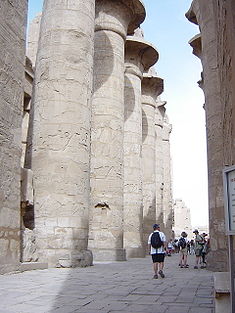
Great Hypostyle Hall, Karnak
Encyclopedia

Karnak
The Karnak Temple Complex—usually called Karnak—comprises a vast mix of decayed temples, chapels, pylons, and other buildings, notably the Great Temple of Amun and a massive structure begun by Pharaoh Ramses II . Sacred Lake is part of the site as well. It is located near Luxor, some...
, in the Precinct of Amon-Re
Precinct of Amon-Re
The Precinct of Amun-Re, located near Luxor, Egypt, is one of the four main temple enclosures that make up the immense Karnak Temple Complex. The precinct is by far the largest of these and the only one that is open to the general public...
, is one of the most visited monuments of Ancient Egypt
Ancient Egypt
Ancient Egypt was an ancient civilization of Northeastern Africa, concentrated along the lower reaches of the Nile River in what is now the modern country of Egypt. Egyptian civilization coalesced around 3150 BC with the political unification of Upper and Lower Egypt under the first pharaoh...
. The design was initially instituted by Hatshepsut
Hatshepsut
Hatshepsut also Hatchepsut; meaning Foremost of Noble Ladies;1508–1458 BC) was the fifth pharaoh of the eighteenth dynasty of Ancient Egypt...
, at the North-west chapel
Chapel
A chapel is a building used by Christians as a place of fellowship and worship. It may be part of a larger structure or complex, such as a church, college, hospital, palace, prison or funeral home, located on board a military or commercial ship, or it may be an entirely free-standing building,...
to Amun
Amun
Amun, reconstructed Egyptian Yamānu , was a god in Egyptian mythology who in the form of Amun-Ra became the focus of the most complex system of theology in Ancient Egypt...
in the upper terrace of Deir el-Bahri
Deir el-Bahri
Deir el-Bahari or Deir el-Bahri is a complex of mortuary temples and tombs located on the west bank of the Nile, opposite the city of Luxor, Egypt....
The hall covers an area of 50000 sq ft (4,645.2 m²). The roof, now fallen, was supported by 134 columns in 16 rows; the 2 middle rows are higher than the others (being 33 feet (10 m) in circumference and 80 feet (24 m) high).
The hall was not begun by Horemheb
Horemheb
Horemheb was the last Pharaoh of the 18th Dynasty from either 1319 BC to late 1292 BC, or 1306 to late 1292 BC although he was not related to the preceding royal family and is believed to have been of common birth.Before he became pharaoh, Horemheb was the commander in chief...
, or Amenhotep III as earlier scholars had thought but was built entirely by Seti I
Seti I
Menmaatre Seti I was a Pharaoh of Ancient Egypt , the son of Ramesses I and Queen Sitre, and the father of Ramesses II...
who inscribed the northern wing of the hall with inscriptions. Decoration of the southern wing was completed by Ramesses II
Ramesses II
Ramesses II , referred to as Ramesses the Great, was the third Egyptian pharaoh of the Nineteenth dynasty. He is often regarded as the greatest, most celebrated, and most powerful pharaoh of the Egyptian Empire...
. A series of later pharaohs added inscriptions to the walls and the columns in places their predecessors had left blank, including Ramesses III
Ramesses III
Usimare Ramesses III was the second Pharaoh of the Twentieth Dynasty and is considered to be the last great New Kingdom king to wield any substantial authority over Egypt. He was the son of Setnakhte and Queen Tiy-Merenese. Ramesses III is believed to have reigned from March 1186 to April 1155 BCE...
, Ramesses IV
Ramesses IV
Heqamaatre Ramesses IV was the third pharaoh of the Twentieth Dynasty of the New Kingdom of Ancient Egypt. His name prior to assuming the crown was Amonhirkhopshef...
and Ramesses VI
Ramesses VI
Ramesses VI was the fifth ruler of the Twentieth dynasty of Egypt who reigned from 1145 BC to 1137 BC and a son of Ramesses III by Iset Ta-Hemdjert...
. The north side of the hall is decorated in raised relief, and was mainly Seti I's work. The southern side of the hall was completed by Ramesses II, in sunk relief although he used raised relief at the very beginning of his reign before changing to the sunk relief style and re-editing his own raised reliefs there. Ramesses II also usurped decoration of his father along the main north-south and east-west processional ways of the hall, giving the casual observer the idea that he was responsible for the building. Most of Seti I's reliefs in the northern part of the hall were respected however.
The outer walls depict scenes of battle, Seti I on the north and Ramesses II on the south. Although these reliefs had religious and ideological functions, they are important records of the wars of these kings. On another wall adjoining the south wall of the Hall is a record of Ramesses II's peace treaty with the Hittites
Hittites
The Hittites were a Bronze Age people of Anatolia.They established a kingdom centered at Hattusa in north-central Anatolia c. the 18th century BC. The Hittite empire reached its height c...
that he signed in Year 21 of his reign.

